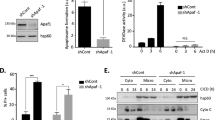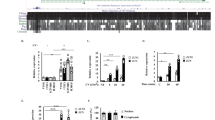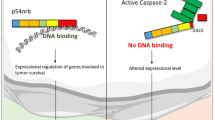Abstract
Bufalin, a component of the Chinese medicine chan'su, induces apoptosis in various lines of human tumor cells, such as leukemia HL60 and U937 cells, by altering the expression of apoptosis-related genes, for example, bcl-2 and c-myc. In this study, we characterized a gene that is involved in bufalin-induced apoptosis by the differential display (DD) technique. The partial nucleotide sequence of one of the differentially expressed clones obtained after treatment with bufalin was identical to that of the human gene for Tiam1. When U937 cells were treated with 10−7 M bufalin, expression of both Tiam1 mRNA and the protein was induced 1 h after the start of the treatment. The increase of Tiam1 mRNA was transient but the level of Tiam1 protein continued to increase at least for 6 h. In addition, the activities of Rac1 and p21-activated kinase (PAK) were also stimulated by bufalin treatment. To evaluate the role of Tiam1 in the apoptotic process, we examined the effects of the expression of sense and antisense RNA for Tiam1 in U937 cells. Apoptosis was strongly induced by bufalin in cells that expressed sense RNA for Tiam1 as compared to apoptosis in control cells treated with bufalin only. Cells expressing antisense RNA for Tiam1 were significantly more resistant than the control bufalin-treated cells to induction of DNA fragmentation in response to bufalin. Moreover, sense transformants had elevated activities of PAK and c-Jun NH2-terminal kinase (JNK). These results suggest that Tiam1 might play a critical role in bufalin-induced apoptosis through the activation of Rac1, PAK, and JNK pathway.
This is a preview of subscription content, access via your institution
Access options
Subscribe to this journal
Receive 50 print issues and online access
$259.00 per year
only $5.18 per issue
Buy this article
- Purchase on Springer Link
- Instant access to full article PDF
Prices may be subject to local taxes which are calculated during checkout







Similar content being viewed by others
References
Barry MA, Behnke CA and Eastman A. . 1990 Biochem. Pharmacol. 40: 2353–2362.
Bhalla K, Ibrado AM, Tourkina E, Tang C, Mahoney ME and Huang Y. . 1993 Leukemia 7: 563–568.
Butterfield L, Storey B, Maas L and Heasley LE. . 1997 J. Biol. Chem. 272: 10110–10116.
Chomczynski P and Sacchi N. . 1987 Anal. Biochem. 162: 156–159.
Colotta F, Polentarutti N, Sironi M and Mantovani A. . 1992 J. Biol. Chem. 267: 18278–18283.
Coso OA, Chiariello M, Yu J, Teramoto H, Crespo P, Xu N, Miki T and Gutkind JS. . 1995 Cell 81: 1137–1146.
Crespo P, Bustelo XR, Aaronson DS, Coso OA, Lopez-Barahona M, Barbacid M and Gutkind JS. . 1996 Oncogene 13: 455–460.
Didsbury JR and Snyderman R. . 1987 FEBS Lett. 219: 259–263.
Franklin CC and Kraft AS. . 1995 Oncogene 11: 2365–2374.
Galcheva-Gargova Z, Derijard B, Wu I-H and Davis RJ. . 1994 Science 265: 806–808.
Habets GGM, Scholtes EHM, Zuydgeest D, Van der Kammen RA, Stam JC, Berns A and Collard JG. . 1994 Cell 77: 537–549.
Han J, Lee J-D, Tobias PS and Ulevitch RJ. . 1993 J. Biol. Chem. 268: 25009–25014.
Han J, Lee J-D, Bibbs L and Ulevitch RJ. . 1994 Science 265: 808–811.
Harlan JE, Hajduk PJ, Yoon HS and Fesik SW. . 1994 Nature 371: 168–170.
Hart MJ, Eva A, Zangrilli D, Aaronson SA, Evans T, Cerione RA and Zheng Y. . 1994 J. Biol. Chem. 269: 62–65.
Jing Y, Ohizumi H, Kawazoe N, Hashimoto S, Masuda Y, Nakajo S, Yoshida T, Kuroiwa Y and Nakaya K. . 1994 Jpn. J. Cancer Res. 85: 645–651.
Kaufmann S. . 1989 Cancer Res. 49: 5870–5878.
Kerr JFR, Wyllie AH and Currie AR. . 1972 Br. J. Cancer 26: 239–257.
Knaus UG, Morris S, Dong H, Chernoff J and Bokoch GM. . 1995 Science 269: 221–223.
Kozma R, Ahmed S, Best A and Lim L. . 1995 Mol. Cell. Biol. 15: 1942–1952.
Kyriakis JM and Avruch J. . 1996 J. Biol. Chem. 271: 24313–24316.
Laemmli UK. . 1970 Nature 227: 680–685.
Laurent-Crawford AG, Krust B, Muller S, Riviere Y, Rey-Cuille MA, Bechet JM, Montagnier L and Hovanessian AG. . 1991 Virology 185: 829–839.
Lee F, Mulligan R, Berg P and Gordon R. . 1981 Nature 294: 228–232.
Liang P and Pardee AB. . 1992 Science 257: 967–971.
Liu ZG, Hsu H, Goeddel DV and Karin M. . 1996 Cell 87: 565–576.
Maniatis T, Fritsch EF and Sambrook J. (eds). . 1982 Molecular Cloning: A Laboratory Manual. pp 188–206.Cold Spring Harbor, NY: Cold Spring Harbor Laboratory.
Manser E, Leung T, Salihuddin H, Zhao Z and Lim L. . 1994 Nature 367: 40–46.
Manser E, Loo T-H, Koh C-G, Zao Z-S, Chen X-Q, Tan L, Tan I, Leung T and Lim L. . 1998 Mol. Cell. 1: 183–192.
Martin SJ, Lennon SV, Bonham AM and Cotter TG. . 1990 J. Immunol. 145: 1859–1867.
Martin SJ, Green DR and Cotter TG. . 1994 Trends Biochem. Sci. 19: 26–30.
Masuda Y, Kawazoe N, Nakajo S, Yoshida T, Kuroiwa Y and Nakaya K. . 1995 Leukemia Res. 19: 549–556.
Michiels F, Habets GGM, Stam JC, Van der Kammen RA and Collard JG. . 1995 Nature 375: 338–340.
Michiels F, Stam JC, Hordijk PL, Van der Kammen RA, Lisette Ruuls-Van Stalle Feltkamp CA and Collard JG. . 1997 J. Cell Biol. 137: 387–398.
Minden A, Lin A, McMahon M, Lange-Carter C, Derijard B, Davis RJ, Johnson GL and Karin M. . 1994 Science 266: 1719–1722.
Nobes CD and Hall A. . 1995 Cell 81: 53–62.
Noguchi K, Nakajima M, Naito M and Tsuruo T. . 1995 Jpn. J. Cancer Res. 86: 217–223.
Numazawa S, Shinoki M, Ito H, Yoshida T and Kuroiwa Y. . 1994 J. Cell Physiol. 160: 113–120.
Obermeier A, Ahmed S, Manser E, Yen S-C, Hall C and Lim L. . 1998 EMBO J. 17: 4328–4339.
Onishi Y, Azuma Y, Sato Y, Mizuno Y, Tadakuma T and Kizaki Y. . 1993 Biochim. Biophys. Acta. 1175: 147–154.
Pierce GB, Lewellyn AL and Parchment RE. . 1989 Proc. Natl. Acad. Sci. USA 86: 3654–3658.
Raingeaud J, Gupta S, Rogers JS, Dickens M, Han J, Ulevitch R and Davis RJ. . 1995 J. Biol. Chem. 270: 7420–7426.
Ridley AJ, Paterson HF, Johnston CL, Diekmann D and Hall A. . 1992 Cell 70: 401–410.
Roulston A, Reinhard C, Amiri P and Williams LT. . 1998 J. Biol. Chem. 273: 10232–10239.
Sawai H, Okazaki T, Yamamoto H, Okano H, Takeda Y, Tashima M, Sawada H, Okuma M, Ishikura H, Umehara H and Domae N. . 1995 J. Biol. Chem. 270: 27326–27331.
Touhara K, Koch WJ, Hawes BE and Lefkowitz RJ. . 1995 J. Biol. Chem. 270: 17000–17005.
Toyoshima F, Moriguchi T and Nishida E. . 1996 J. Cell Biol. 139: 1005–1015.
Vaux DL, Cory S and Adams JM. . 1988 Nature 335: 440–442.
Verheij M, Bose R, Lin XH, Yao B, Jarvis WD, Grant S, Birrer MJ, Szabo E, Zon LI, Kyriakis JM, Haimovitz-Friedman A, Fuks Z and Kolesnick RN. . 1996 Nature 380: 75–79.
Vojtek AB and Cooper JA. . 1995 Cell 82: 527–529.
Walker PR, Smith C, Youdale T, Leblanc J, Whitefield JF and Sikorska M. . 1991 Cancer Res. 51: 1078–1085.
Watabe M, Masuda Y, Nakajo S, Yoshida T, Kuroiwa Y and Nakaya K. . 1996 J. Biol. Chem. 271: 14067–14073.
Watabe M, Ito K, Masuda Y, Nakajo S and Nakaya K. . 1998 Oncogene 16: 779–787.
Wyllie AH. . 1980 Nature 284: 555–556.
Xia Z, Dickens M, Raingeaud J, Davis RJ and Greenberg ME. . 1995 Science 270: 1326–1331.
Zhang LS, Nakaya K, Yoshida T and Kuroiwa Y. . 1991 Biochem. Biophys. Res. Commun. 178: 686–693.
Acknowledgements
This work was supported in part by Grants-in-Aid from the Ministry of Education, Science and Culture of Japan. The authors are grateful to Dr K Todokoro (Institute of Physical and Chemical Research, Tsukuba, Japan) for the gift of the reporter plasmid that encoded GST-c-Jun (1 – 79).
Author information
Authors and Affiliations
Rights and permissions
About this article
Cite this article
Kawazoe, N., Watabe, M., Masuda, Y. et al. Tiam1 is involved in the regulation of bufalin-induced apoptosis in human leukemia cells. Oncogene 18, 2413–2421 (1999). https://doi.org/10.1038/sj.onc.1202555
Received:
Revised:
Accepted:
Published:
Issue Date:
DOI: https://doi.org/10.1038/sj.onc.1202555
Keywords
This article is cited by
-
An unexpected reaction of cinobufagin analogues in the presence of PPh3/I2
Monatshefte für Chemie - Chemical Monthly (2020)
-
Anti-angiogenic function of a Korean Ginseng and Toad venom complex, Doksamsumsu-dan (DSSSD) analyzed by a forwarded phase antibody microarray
BioChip Journal (2015)
-
Bufalin induces cell cycle arrest and apoptosis in gallbladder carcinoma cells
Tumor Biology (2014)
-
Inhibition of Jak-STAT3 pathway enhances bufalin-induced apoptosis in colon cancer SW620 cells
World Journal of Surgical Oncology (2012)
-
Digitoxin and its analogs as novel cancer therapeutics
Experimental Hematology & Oncology (2012)



